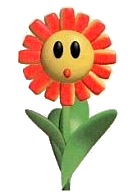Power Flower (Yoshi's Story)
| Power Flower | |
|---|---|
 Artwork from Yoshi's Story | |
| Appears in | Yoshi's Story (1997) |
| Effect | Heals a Yoshi when eaten |
A Power Flower is a special sunflower that appears in Yoshi's Story. It grows from the ground and has a green stem with green leaves, as well as a yellow head with red petals, black eyes, and a small red mouth. The head of a Power Flower can be consumed by a Baby Yoshi, and if he does so, the Yoshi receives two heart outlines. This allows him to recover two petals on his Smile Meter, but it does not earn him any points, unlike eating a fruit or a Shy Guy, and thus does not improve Yoshi's Mood when the stage is completed. The head of the Power Flower quickly regrows after being consumed, meaning that the Yoshi can simply keep eating flower heads until his health is fully recovered. The Power Flower is akin to the Spinning Heart of Super Mario 64, as both objects can be used to quickly (but not immediately) recover all health.
Power Flowers appear in Sonic Lost World in the DLC level Yoshi's Island Zone, released for free to owners of the Wii U version.[1]
Profiles and statistics[edit]
- Message Block:
Gallery[edit]
Sonic Lost World (top right)
Names in other languages[edit]
| Language | Name | Meaning | Notes |
|---|---|---|---|
| Japanese | ニコニコフラワー[4] Nikoniko Furawā |
Smiley Flower | |
| 花[5] Hana |
Flower | ||
| French | Fleur magique[3] | Magic flower |
References[edit]
- ^ Carter, Chris (December 18, 2013). Impressions: Sonic Lost World Yoshi’s Island Zone. Destructoid (English). Retrieved September 18, 2020.
- ^ Yoshi's Story in-game name (Uploaded 1 Oct. 2017 on YouTube by Lollie)
- ^ a b Yoshi's Story in-game name from French localization (Uploaded 4 Mar. 2019 on YouTube by Omniwalk FR)
- ^ >1998. 「ヨッシー全百科」(Yoshi All Hyakka). Shogakukan (Japanese). ISBN 4-09-281158-6. Page 40. Retrieved from Internet Archive. (Archived via Ragey0.)
- ^ 「ヨッシーストーリー 任天堂公式ガイドブック」(Yoshi's Story Nintendo Kōshiki Guidebook). Shogakukan (Japanese). Page 12.



